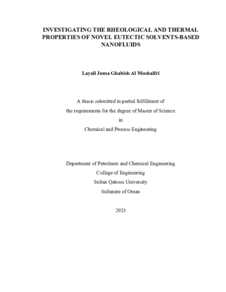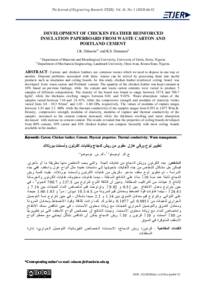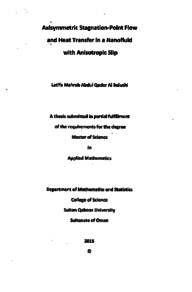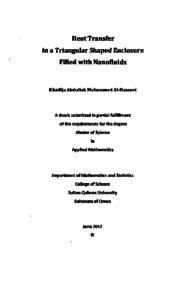Document
Investigating the rheological and thermal properties of novel eutectic solvents-based nanofluids.
Source
Master's thesis
Other titles
دراسة الخصائص الريولجية والحرارية للموائع النانوية القائمة على المذيبات عميقة الانصهار
Country
Oman
City
Muscat
Publisher
Sultan Qaboos University
Gregorian
2023
Language
English
Subject
Thesis Type
Master's thesis
English abstract
In the quest for higher performance and energy efficiency, nanofluids play a crucial role
in revolutionizing heat transfer processes. Their innovative properties offer enhanced
thermal management and sustainability across various applications. In this work, novel
nanofluids were prepared utilizing environmentally friendly nanoparticles made of
Powdered Activated Carbon supported Carbon Nanotubes (PAC-CNT) dispersed in a
base fluid made of a binary eutectic solvent consisting of ethylene glycol and imidazole.
Compared to traditional working fluids, this base fluid is distinguished by its thermal and
chemical stability and low vapor pressure. Six nanofluids were prepared with different
nanoparticle concentrations (0.08, 0.1, and 0.12 wt%). These were mechanically dispersed
in two systems of base fluids with 1:2 and 1:3 molar ratios of imidazole to ethylene glycol.
The stability of the nanofluids was tested by measuring their zeta potential. The
rheological behavior of the working fluids was determined at different shear rates. An
experimental investigation was conducted to find the effect of temperature, nanoparticles
concentration, and base fluid composition molar ratio on the thermophysical properties of
the base fluids and the nanofluids.
The lower base fluid ratio achieved less viscosity. The viscosity increments with adding
NPs were higher in nanofluids with the (1:3 IM:EG) system. There was a slight change in
density with the increasing nanoparticles load, and the density of all tested fluids
decreased with temperature. Determining the pumping requirement for nanofluids is also
essential for heat transfer applications. A model was used to estimate the pumping power
demand of the nanofluids by considering their rheological characteristics and their
measured density and viscosity. The interactions between the nanoparticles and the base fluid molecules affected the enhancement of the thermal properties of the nanofluids. The nanofluids containing 0.08 wt% of nanoparticles achieved a maximum enhancement in specific heat in both base fluid systems. These enhancements reached 10% and 44%,
respectively. The thermal conductivity (TC) was also enhanced by adding nanoparticles
to the base fluid. A remarkable 273% increase in TC was achieved with a nanoparticles
concentration of 0.08% in the first system (1:2 IM:EG). On the other hand, the
improvement in TC was lower in the second system as it reached 57% with 0.08 wt%
nanoparticles content. This research contributes valuable insights into the potential
applications of the studied nanofluids for enhanced heat transfer performance in various
engineering and industrial applications.
Arabic abstract
تلعب السوائل النانوية دورا حاسما في إحداث ثورة في عمليات نقل الحرارة في السعي إلى تحقيق أداء وكفاءة أعلى في استخدام الطاقة. توفر خصائصها المبتكرة إدارة حرارية معززة واستدامة عبر مختلف التطبيقات. في هذا البحث، تم إعداد سوائل نانوية جديدة باستخدام جسيمات نانوية صديقة للبيئة مصنوعة من أنابيب الكربون النانوية -PAC( (CNTفي سائل أساسي مصنوع من مذيب أيوتكتيكي ثنائي يتكون من جليكول اإلثيلين وإيميدازول. ويتميز هذا السائل األساسي باستقراره الحراري والكيميائي بالإضافة إلى ضغط التبخر المنخفض مقارنة بسوائل العمل التقليدية. تم إعداد ستة من السوائل النانوية بتركيزات مختلفة من الجسيمات النانوية )،0.08 0.1 و0.12 wt٪). كانت هذه متباينة ميكانيكيا في نظامين من السوائل األساسية بنسبة مولية 1:2 و1:3 من إيميدازول إلى جليكول اإلثيلين. تم اختبار استقرار السوائل النانوية من خالل قياس جهد زيتا. تم تحديد السلوك الريولوجي لسوائل العمل بمعدالت مختلفة من القص. أجري بحث تجريبي لمعرفة تأثير درجة الحرارة، وتركيز الجسيمات النانوية، ونسبة تكوين السائل األساسي على الخصائص الفيزيائية الحرارية للسوائل األساسية والسوائل النانوية. حققت نسبة السوائل األساسية المنخفضة لزوجة أقل. كانت زيادة اللزوجة مع إضافة NPs أعلى في السوائل النانوية مع نظام.(EG:IM 1:3 (كان هناك تغيير طفيف جدا في الكثافة مع زيادة حمل الجسيمات النانوية، وانخفضت كثافة جميع السوائل المختبرة مع درجة الحرارة. تحديد متطلبات الضخ للموائع النانوية مهم أيضا لتطبيقات نقل الحرارة. فقد تم استخدام نموذج لتقدير الطلب على طاقة الضخ من السوائل النانوية من خالل النظر في الخصائص الريولوجية وكثافتها المقاسة واللزوجة. وقد أثرت التفاعالت بين الجسيمات النانوية وجزيئات السوائل األساسية على تحسين الخصائص الحرارية للسائل النانوي. حققت السوائل النانوية التي تحتوي على 0.08 wt٪ من الجسيمات النانوية أقصى تعزيز في حرارة محددة في كل من أنظمة السوائل األساسية. وبلغت هذه التعزيزات ٪10 و٪44 على التوالي. كما تم تعزيز الموصلية الحرارية (TC (من خالل إضافة جسيمات نانوية إلى السائل األساسي. تحققت زيادة ملحوظة بنسبة ٪273 في TC مع تركيز الجسيمات النانوية بنسبة ٪0.08 في النظام األول .(EG:IM 1:2 (من ناحية أخرى، كان التحسن في TCأقل في النظام الثاني حيث بلغ ٪57 مع 0.08 wt٪ محتوى الجسيمات النانوية. يساهم هذا البحث في تقديم رؤى قيمة حول التطبيقات المحتملة للموائع النانوية المدروسة لتحسين أداء نقل الحرارة في مختلف التطبيقات الهندسية والصناعية.
Category
Theses and Dissertations





